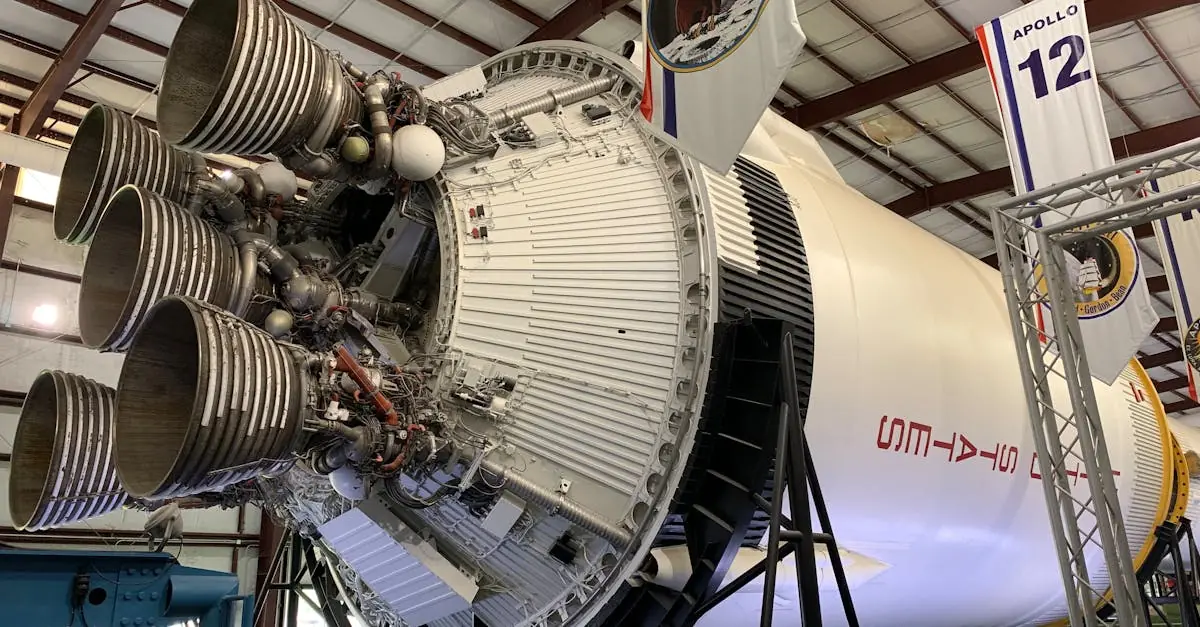Rocket propulsion systems are the unsung heroes of space exploration, turning dreams of interstellar travel into reality. Imagine strapping a giant firework to your back and blasting off into the cosmos—sounds fun, right? But behind that thrilling image lies a complex world of engineering and physics that fuels humanity’s quest to explore beyond our blue planet.
Table of Contents
ToggleOverview of Rocket Propulsion Systems
Rocket propulsion systems serve as the backbone of space exploration. These systems generate thrust by expelling mass in the opposite direction. The main components include engines, fuel, and oxidizers, each designed to optimize performance. Various types of propulsion systems exist, with chemical, electric, and nuclear options leading the way.
Chemical propulsion systems rely on chemical reactions to produce thrust. Propellant combinations, such as liquid oxygen and liquid hydrogen, ignite in combustion chambers, creating high-speed exhaust gases. Liquid rocket engines provide controlled thrust, while solid rocket boosters offer simplicity and reliability.
Electric propulsion systems utilize electric or magnetic fields to accelerate ions. Ion thrusters operate with high efficiency, making them suitable for deep space missions. They function at low thrust, requiring extended periods to achieve significant velocities. Companies like NASA and the European Space Agency have successfully employed these systems in missions like the Dawn spacecraft.
Nuclear thermal propulsion represents another innovative approach. This system uses nuclear reactions to heat a propellant, typically hydrogen, producing thrust. Promising advancements in this technology could reduce travel time to Mars and enhance deep space exploration capabilities.
Propulsion technology continues to evolve. Future developments aim to improve efficiency and expand mission profiles. Emerging concepts like space-based propulsion and hybrid systems may redefine capabilities for interstellar travel. As engineers refine these systems, they pave the way for new frontiers and possibilities in space exploration.
Types of Rocket Propulsion Systems
Rocket propulsion systems consist of various types that cater to different mission profiles. These systems primarily include chemical, electric, and hybrid propulsion.
Chemical Propulsion
Chemical propulsion generates thrust through chemical reactions. These systems use propellants like liquid oxygen and liquid hydrogen or solid fuels. Upon combustion, the rapid expansion of gases produces thrust. This method remains the most commonly used type for launching rockets due to its high thrust-to-weight ratio. For example, the Space Shuttle utilized a combination of solid rocket boosters and liquid engines during its ascent. Chemical propulsion supports missions from Earth, reaching low Earth orbit and beyond with proven reliability.
Electric Propulsion
Electric propulsion represents a highly efficient alternative for deep space exploration. This system employs electric or magnetic fields to accelerate charged particles, producing thrust. Ion thrusters, known for their long operational life, exemplify this technique. They consume less propellant than conventional systems, making them ideal for missions requiring extended durations. NASA’s Dawn spacecraft used xenon gas in its ion propulsion system, demonstrating the capabilities of electric propulsion. Enhanced efficiency allows spacecraft to travel greater distances while conserving fuel.
Hybrid Propulsion
Hybrid propulsion blends elements of both solid and liquid propulsion systems. This approach typically utilizes a solid fuel combined with a liquid oxidizer. It offers flexibility during mission operations and enhances thrust control. By adjusting the flow of the liquid oxidizer, engineers can modulate thrust levels throughout the flight. Notably, SpaceShipTwo employs a hybrid engine that delivers unique performance benefits for suborbital flights. As technology advances, hybrid systems may pave new paths in rocket design and operation.
Key Components of Rocket Propulsion Systems
Rocket propulsion systems consist of essential components that enable thrust generation for space missions. Understanding these components—propellant types and engine designs—provides insight into their functionalities.
Propellant Types
Liquid and solid propellants are the primary options. Liquid propellants, such as liquid oxygen and liquid hydrogen, undergo combustion to create high-pressure gases. Solid propellants consist of a mixture that burns uniformly, producing thrust from the solid state. Hybrid propellants combine features of liquid and solid systems for improved control. Each variety offers distinct advantages, influencing mission profiles and operational efficiency. For instance, rocket systems like the Space Shuttle relied on liquid propellants for high thrust at liftoff. Meanwhile, satellites often utilize solid propellant boosters to manage limited space and weight.
Engine Designs
Engine designs vary widely, catering to specific operational needs. Liquid engines incorporate complex plumbing systems for fuel delivery, thus allowing precise thrust control. Solid engines present simplicity through easy handling and minimal maintenance. They produce consistent thrust over their burn duration. Advanced designs, like aerospike engines, adapt their performance based on altitude changes, optimizing efficiency. Electric engines, such as those using ion propulsion, excel in deep space missions, relying on electricity to propel ions. Each design serves unique purposes in missions, supporting diverse space exploration efforts.
Performance Metrics for Rocket Propulsion
Performance metrics play a crucial role in assessing the effectiveness of rocket propulsion systems. Key metrics include thrust and specific impulse, both of which are critical for evaluating propulsion efficiency and capability.
Thrust
Thrust represents the force generated by a rocket engine. It measures how much mass the engine can expel to create movement. High thrust often correlates with rapid acceleration, essential for overcoming Earth’s gravitational pull. Chemical propulsion systems typically deliver high thrust, evidenced by the Space Shuttle’s engines producing approximately 1.5 million pounds of thrust. Electric propulsion systems, although lower in thrust, provide continuous acceleration for longer durations. As a result, choices between these propulsion methods depend on mission goals and vehicle weight.
Specific Impulse
Specific impulse quantifies engine efficiency by evaluating thrust relative to propellant usage. It represents how effectively a rocket converts propellant into thrust over time. Measured in seconds, higher specific impulse indicates better performance. For instance, chemical engines achieve specific impulses around 300 seconds, while electric engines, such as ion thrusters, can exceed 3,000 seconds. This metric emphasizes the trade-off between thrust and fuel consumption during missions. Selecting the appropriate propulsion system hinges on achieving an ideal balance between these metrics for efficient space travel.
Future Trends in Rocket Propulsion Technology
Innovations in rocket propulsion technology continue to advance at a rapid pace. Researchers and engineers are exploring new propellants that enhance performance and reduce environmental impact. Methane-based fuels, for example, offer promising advantages for both launch missions and in-space operations, thanks to their potential for in-situ resource utilization on Mars.
Electric propulsion also sees significant advancements. Companies like SpaceX and NASA are developing next-generation ion thrusters and Hall effect thrusters. Improved designs aim to achieve higher thrust and efficiency, extending the operational life of spacecraft during deep space missions.
Emerging technologies like nuclear thermal propulsion are changing the landscape as well. This method utilizes nuclear energy to heat propellant, providing a higher specific impulse than traditional chemical rockets. The potential for faster travel times to distant destinations, such as Mars, attracts attention from various space agencies.
Additionally, the evolution of additive manufacturing impacts propulsion systems. 3D printing enables complex engine designs that enhance performance while reducing production costs. This innovation paves the way for customization of components, fostering greater experimentation in rocket designs.
Lastly, advanced materials play a vital role in future propulsion systems. Lightweight composites and heat-resistant alloys contribute to improved engine performance and reliability. Continuous material research supports the goal of creating more durable engines capable of withstanding extreme conditions during launch and deep space missions.
Overall, the future of rocket propulsion technology promises groundbreaking developments that enhance the efficiency, sustainability, and versatility of space exploration capabilities.
Conclusion
Rocket propulsion systems are vital for the future of space exploration. They enable humanity to push boundaries and explore the cosmos. As technology advances the potential for new propulsion methods grows, promising faster and more efficient travel. Innovations like methane-based fuels and electric propulsion systems are paving the way for deeper space missions.
The integration of 3D printing and advanced materials further enhances engine performance and reliability. With ongoing research and development the possibilities for rocket propulsion seem limitless. As these systems evolve they will undoubtedly play a key role in humanity’s quest to explore and understand the universe.






